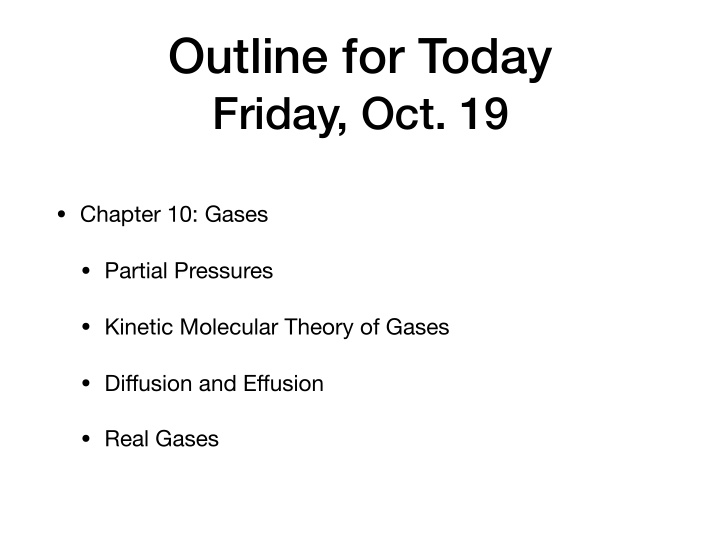



Outline for Today Friday, Oct. 19 • Chapter 10: Gases • Partial Pressures • Kinetic Molecular Theory of Gases • Di ff usion and E ff usion • Real Gases
Example: Using the Ideal Gas Equation in a Stoichiometry Problem • In Andy Weir’s The Martian, the astronaut Mark Watney finds himself in a situation where he needs to make water from H 2 and O 2 gases. How many L of H 2 (g) and O 2 (g) does he need to make 1.0 L of liquid water ( density = 0.997 g/mL )? Pressure in H 2 and O 2 tanks is 5.0 atm and the temperature inside the station is 20 o C .
Example: Partial Pressures and Reactions • A chemist is studying O 3 formation in the troposphere. In her 100.0 L reaction container she has a mixture of CO, O 2 and N 2 . She is studying the reaction: • CO (g) + 2O 2 (g) ➞ CO 2 (g) + O 3 (g) • The initial partial pressures at 25 o C are: P CO = 0.10 atm P O 2 = 0.20 atm P N 2 = 0.80 atm • What are the final partial pressures of all of the molecules after the reaction?
Our Model of Ideal Gases is based on the Kinetic Molecular Theory of Gases 1. The volume of gas molecules is negligible compared to total volume. 2. Gas molecules neither attract nor repel each other. 3. They have completely elastic collisions with each other. 4. Molecules move in continuous random motion . http://www.falstad.com/gas/ 5. Average kinetic energy (motion) is proportional to temperature .
Gas molecules have a distribution of molecular speeds
Molecular speeds increase as temperature increases
Gases with different molecular weights have different distributions of speeds
Diffusion and Effusion
Gases deviate from ideal behavior at high pressures
Gases are less ideal at lower temperatures
Real gases deviate from ideal behavior 1. The volume of gas molecules is negligible compared to total volume. 2. Gas molecules neither attract nor repel each other. 3. They have completely elastic collisions with each other. 4. Molecules move in continuous random motion . http://www.falstad.com/gas/ 5. Average kinetic energy (motion) is proportional to temperature .
Real gases deviate from ideal behavior: van der Waal Equation 1. The volume of gas molecules is negligible compared to total volume. PV = nRT 2. Gas molecules neither attract nor repel each other. P + n 2 a ✓ ◆ 3. They have completely elastic ( V − nb ) = nRT V 2 collisions with each other. 4. Molecules move in continuous random motion . 5. Average kinetic energy (motion) is proportional to temperature .
Using the van der Waal Equation for Real Gases • What is the pressure for 1.00 mol of an ideal gas in 22.41 L at 0.00 o C? • Is the pressure higher or lower for CO 2 (g) (van der Waal parameters: a=3.59 L 2 atm/mol 2 , b=0.0427 L/mol)? P + n 2 a ✓ ◆ ( V − nb ) = nRT V 2
Recommend
More recommend